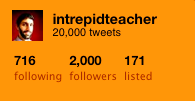I am not gonna lie, I am feeling tired, a bit burnt out and lazy. It is Friday morning, I have a few preps to get some work done, but I am mostly caught up, so it is the perfect time to do a quick write up for the second meeting of our blogging club. The problem is I don’t really feel like doing it.
This is where modeling behavior you like to see comes in. One of the biggest questions I get from new teachers to blogging and interacting with the social web is, “Where do you find the time?” The answer is I don’t find the time. Time is not something that is found; it is made. It is shaped. Expanded and collapsed. It is used or misused. So while I could just relax and maybe surf the web, or perhaps work on my Areas of Interaction wall display, or finish up the work on my ESL oral assessments, I am choosing to take twenty minutes and quickly jot done a few ideas about our second session. Why? Because I believe in the value of routine and writing and reflection and blogging. Time is a choice, or better stated a series of choices.
While some may see the use of twenty minutes as a frivolous hobby, I see it as professional development. I see it as my chance to reflect on the work I do. This reflection and growth professionally and personally is one of the most important aspects of my life. I see it as time well spent, not wasted. We are all busy. Take a look at Dean Shareski’s thoughts on the subject of busyness, but we have a choice on how we use our time. So without further ado. A quick recap:
1. I came to the conclusion that perhaps many of the participants are not ready or willing, or need to commit to this level of involvement with their own reflection. They do not want to create a professional blog where they ponder the merits of online communication and community building. They simply want to learn how to use the tool to create a space that will help them connect with, and engage with their students and parent community. I also learned that this is okay. We cannot expect that everyone will find value in one model of blogging. The secret I think is to offer people exposure, show them the options and help guide them to where they want to go, not where we want to take them.
If our elementary school art teacher wants to create a platform to share student work with a wider audience, instead of writing about the process, that is totally okay. I need to find out where she is and help move her to where she wants to go. So many times technology enthusiasts want to show everyone everything at once, and are shocked that perhaps a teacher doesn’t want to follow.
2. I got a good sense of what everyone wants from their blogs and we began to discuss and explore design and platforms. Teachers are using Blogger and WordPress themes. I did some research to try and find the best tool for embedding slideshows on a Blogger account and feel I found some great choices to offer. The question for me, however, is how can I empower the teachers to find these options for themselves? How can we demonstrate to teachers that there is value in taking time to research solutions to the problems they face? How can we show them that struggling with technology is what learning looks like, and in the long run figuring out how to do something for yourself is not wasting time, but actually it is them learning?
I don’t want to take anymore of your time, but I am curious of what you think. If you are one of the teachers here at SWA, please leave a comment, and let’s see if we can carve out a conversation as we help build the tools you need. Take ten minutes and try to hash out your thoughts. They don’t have to be complete or perfect. This point cannot be better made than by reading over this post and highlighting the many typos and mistakes. A blog is a place to reflect and talk, not to write your opus.
I want to close by saying how great it is that you do make the time every week to join us and learn about something new. Thank you. Your time is valued and appreciated, because I know you could be doing a million other things.


